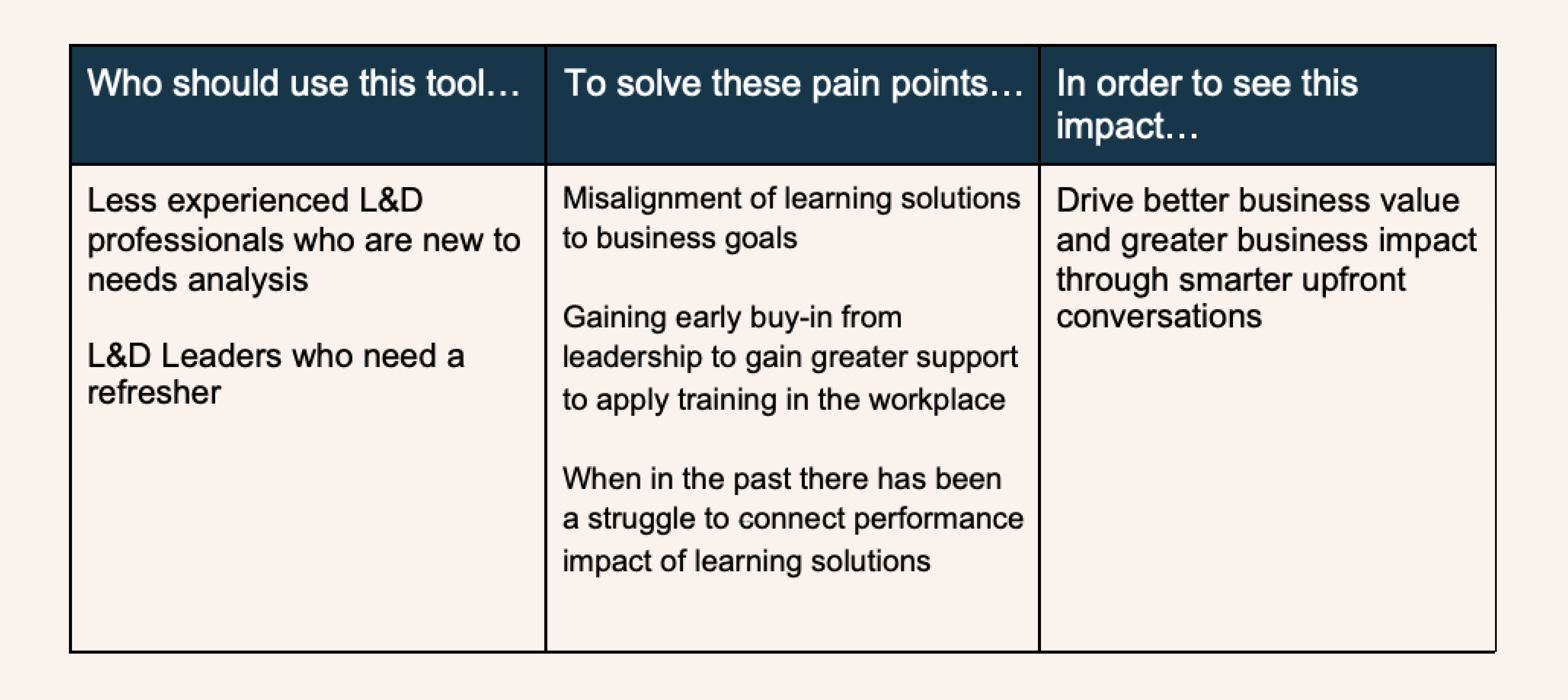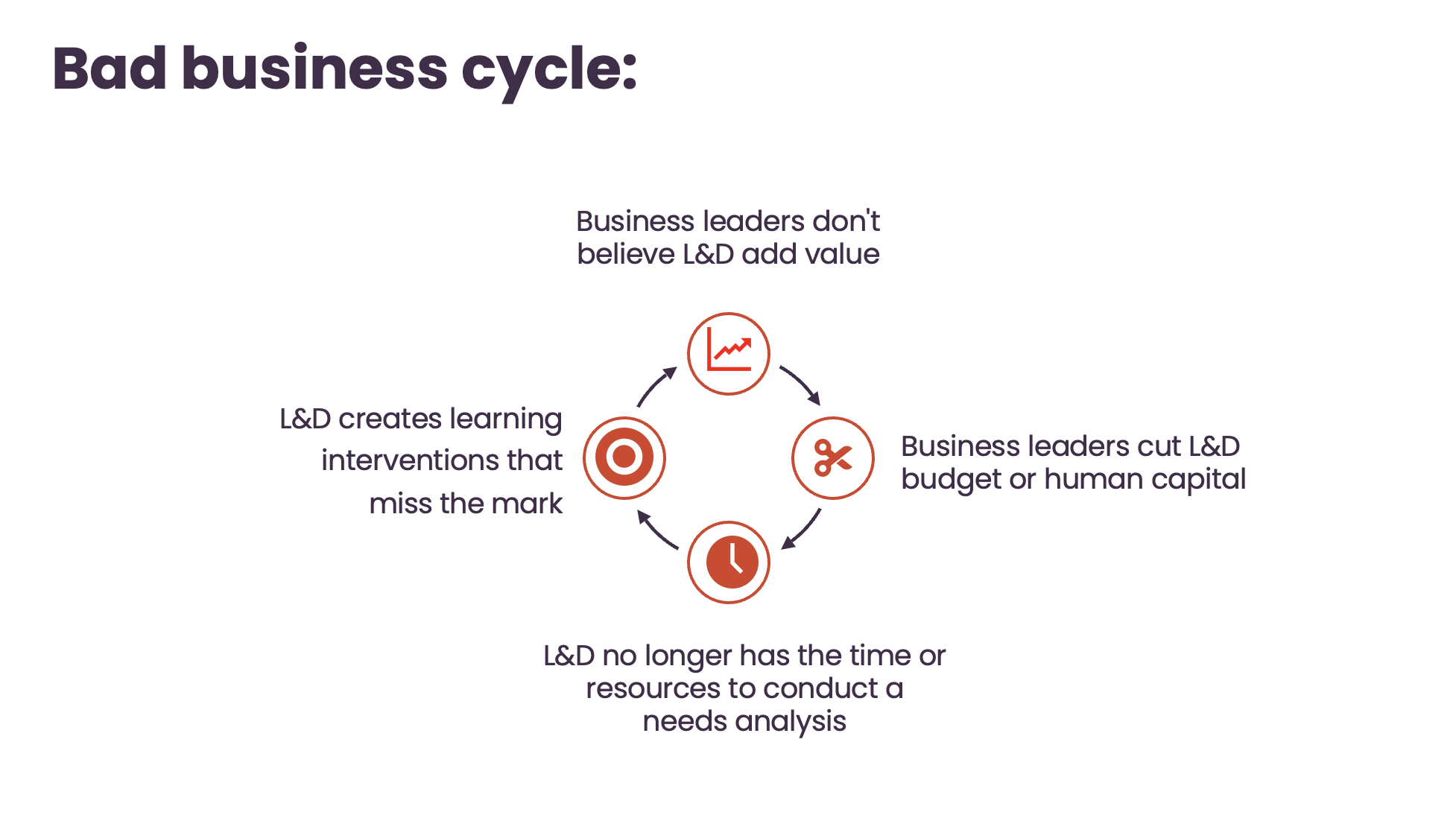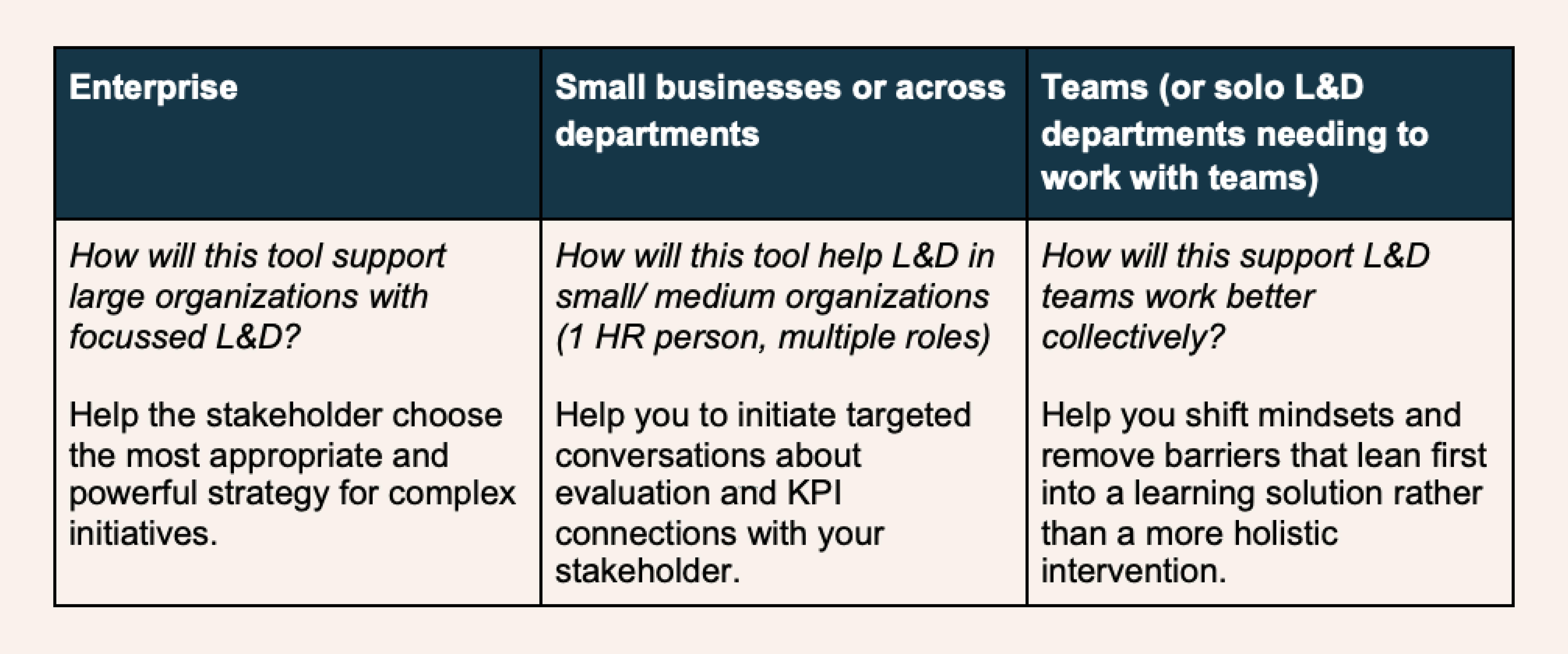
Making it simple to conduct a needs analysis conversation

Written by guest blogger Shannon Tipton. Chief Learning Officer of Learning Rebels LLC and co-founder of Emerging Stronger, Shannon's mission is to modernize, upgrade and reimagine workplace learning problems. She believes that by making complex training more interesting, engaging and impactful, training is transformed from being just another organizational event to becoming part of real business solutions.
Over the past year, the Emerging Stronger team have developed a series of tools to make it simple for L&D professionals to embrace evidence-informed tactics to improve business impact. In the first of this series of Making It Simple To Do The Right Thing, Shannon Tipton introduces you to the Needs Analysis Tool.

Needs analysis: connecting what matters most
Let’s face it - as an L&D professional, you want to make sure your courses and content add the most value to your people and make the greatest impact to address the real underlying problem.
In reality, sometimes they don't. Just because a stakeholder asks for training, it doesn't mean that training is the best thing for the business. What the stakeholder wants and what the stakeholder needs are often two very different things. Your job is to help them see the difference.
This post, when worked in conjunction with the Emerging Stronger Needs Analysis Tool, will make it easier for you to have critical upfront business needs conversations with business leaders and/or business sponsors. Thus gaining the business impact desired.
Here we will guide you through using the Needs Analysis Tool by supplying you with helpful suggestions as to how best to use the tool.
Here the Emerging Stronger team shares the impact of this tool:
Needs analysis - the missing link?
According to LinkedIn Learning’s 5th Annual Workplace Learning Report 2021, 66% of L&D professionals globally agree that they are focused on rebuilding and reshaping their organizations in 2022.
Yet, in a survey conducted by the CEB, only 33% of business leaders think the L&D function impacts business outcomes, and fewer consider the function to be relevant or timely.
It’s an ugly cycle in which L&D finds itself time and time again.
- Business leaders don’t believe L&D adds value
- Business leaders cut L&D budget or human capital
- L&D no longer has the time or resources to conduct a needs analysis
- L&D creates learning interventions that miss the mark

Wash, rinse, repeat.
Wouldn’t you rather elevate L&D’s position from being a low-value add expense to a trusted business partner? Of course you would and Emerging Stronger has your back! We are providing this easy-to-use tool to help you do the heavy lifting of a needs analysis and place you in the “trusted business partner” category.
An overview of the Needs Analysis Tool:
Ideally, this tool would be used before you start designing a solution. Your needs analysis conversation will consist of two steps:
Step 1 - Identifying the business needs
a. Start the conversation
b. Identify business benefits
c. Define success
d. Gather data
Step 2 - Identifying the audience's needs
a. Identify target groups
b. Define actions to be taken by group
c. Describe group
d. Identify limiting factors
e. Determine if a learning solution will help
This tool provides guidance notes for each part of the conversation, including conversation starters/prompters.
What makes this easy to use is that the notes are followed by a template to record output. Plus, a worked example is provided to show you what a completed template might look like.
All to help make it simple to do the right thing, to help consult on business challenges. Because the key to your conversations is to get to the heart of the issue. Plus, if the stakeholder can’t speak to or define the knowledge, skills, or behavior gaps that are contributing to the business challenge, it’s a red flag that training might not be needed or is not the right solution. And you want to know that upfront before you put a learning intervention together that misses the mark, and the ugly cycle from above continues.
Scaling your needs analysis
Realizing that not everyone is facing the same situations, even within the same organization, we gathered ideas to help you apply this tool to gain impact:

Next steps
All of this is to help you step out of the order-taker role and into the role of a business partner.
It's about helping you to determine the variety of questions you need to ask and engaging the stakeholders and getting a better understanding of your audience and getting aligned on what the actual business need may be.
It’s about understanding and working within and around the barriers within your workplace. Then taking all of that information and asking: “So what? Now what? What does this information tell me about the potential intervention - learning focused or not? Then - adding the cherry on top, what can I do to make sure that I am adding value?”
Some tools work just fine on their own, however, others work at their best when combined with other complementary tools. Fertilizer alone works just fine to nourish plants, but when coupled with good soil and mulch the results are ten-fold.
Using this Needs Analysis Tool alone will help you see the results discussed and coupled with the other tools in this series it becomes even more simple to do the right thing and see results that increase business impact.
Ready to connect to what matters most? Download your Needs Analysis Tool now!
Other tools in this series:
Curation Decision Tool: Once your needs assessment points you in a specific direction, how can you better curate and disseminate resources and tools?
Communication Launch Tool: Your learning intervention is on its way, how will you communicate and implement its purpose? Just because you build it, doesn’t guarantee success.
Power Hour Tool: Sometimes the biggest barrier to training success is “INSIDE.THE.HOUSE”. The Power Hour tool can help you bring managers into the discussion sooner and enable them to be part of the learning process.
Workplace Communities Tool: Perhaps your analysis tells you it’s not more learning required but a connection to the community. This tool helps identify workplace communities with fertile ground and how to take action to help learning thrive.
Improving Impact Tool: Your needs analysis sets you up for success, the improving impact took keeps you on track to deliver.
You may also be interested in the other blogs in this series:
Making it simple to curate with impact, which dives into moving beyond learning aggregation with the Curation Decision Tool.
Making it simple to engage with managers, Laura Overton talks through improving engagement with managers with The Power Hour Tool.
Making it simple to market learning and increase engagementMaking it simple to market learning and increase engagement, with Laura Overton exploring how to best spread the word on your learning solution with the Communication Plan Launch Tool.
Making it simple to improve impact, Laura Overton walks through a powerful and adaptive resource, the Improving Impact Tool.
Making it simple to cultivate learning in workplace communities, where Shannon Tipton presents ways to empower the communities at play with the Cultivating Learning Tool.
For more insights, subscribe to the Go1 newsletter to stay on top of all the latest L&D trends. Or, you can book a demo today to find out how Go1 can help with your team’s learning needs.




